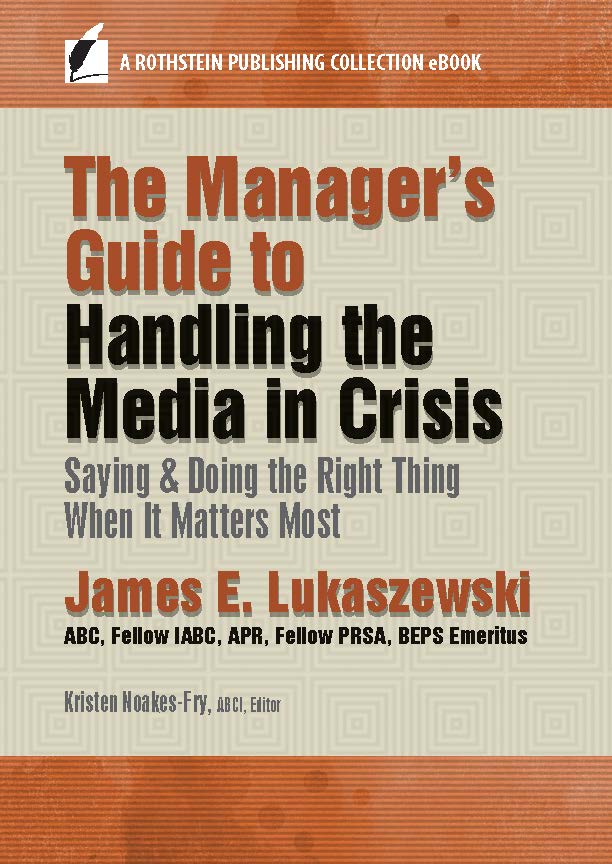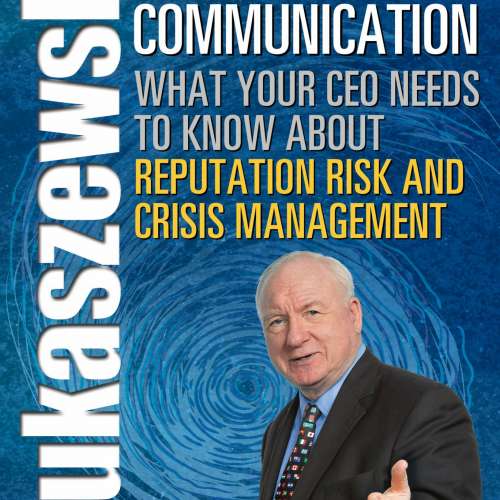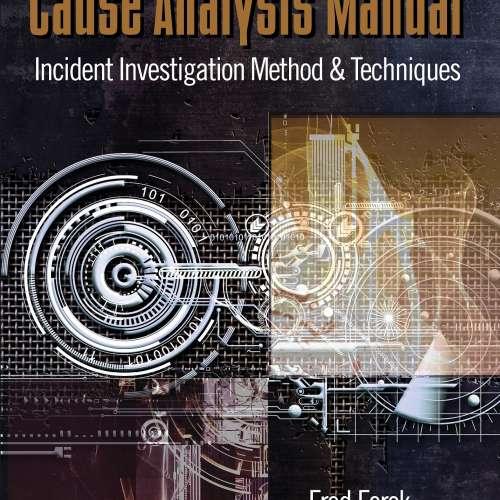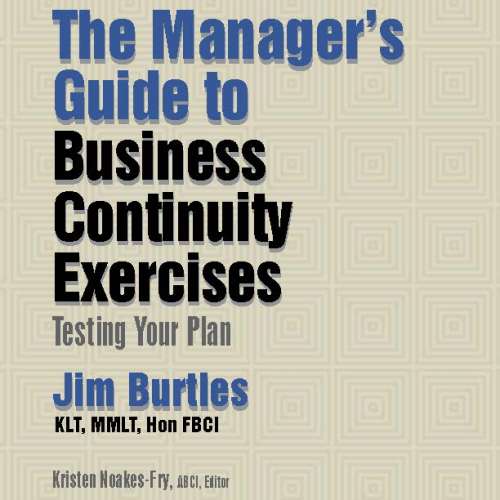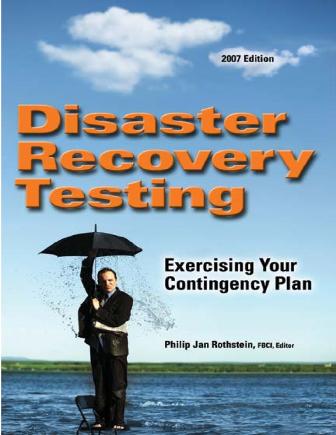Description
Reading this book, you will see why, wherever there is or can be trouble and crisis, affected audiences and troubled leaders are waiting to learn the way out of their problems from Jim Lukaszewski in his Guide to Handling The Media in Crisis.
The book is practical, easy to read, filled with real-world case studies, checklists, anecdotes, discussion questions, and easy-to-remember tips for success.
With this book as your guide to handling the media in crisis, you will be able to:
- Create and deliver the message that best represents your organization.
- Understand what it takes to be an effective spokesperson.
- Make sure everyone is aware of company policies and procedures relating to the press.
- Be aware of the needs, deadlines, and priorities of reporters.
- Prepare to give good answers to all sorts of questions.
- Monitor social media, assess its impact.
- Identify the ways social media could be used to attack your company.
- Preserve company reputation amid a flurry of conflicting publicity.
James (Jim) Lukaszewski, America’s Crisis Guru, ABC, Fellow IABC, APR, Fellow PRSA, BEPS Emeritus, is one of the most visible corporate go-to people for companies when there is trouble in the room or on the horizon. The Manager’s Guide to Handling the Media in a Crisis: Doing and Saying the Right Thing When it Matters Most, shares with you the skills he has developed in 30+ years of helping companies in crisis management, employee communications, ethics, media relations, public affairs, reputation preservation, leadership restoration, and recovery. Jim speaks annually before a wide variety of local, statewide, national and international organizations and associations heard by thousands of each year – and in this book, he is speaking directly to you.
October, 2016, 141 pages, ISBN 978-1-944480-29-5 (PDF), ISBN 978-1-944480-28-8 (EPUB)
Contents
Table of Contents
Cover
Title Page
Copyright
Preface
Part 1: Understanding Media Relations
1.1 The Crisis Media Relations Policy
1.1.1 Sample Crisis Media Relations Policy
1.1.2 Guidelines for Designated Spokespersons
1.1.3 Good Spokesperson Practices
1.1.4 Setting the Record Straight if You Make a Mistake
1.2 The Crisis Website (or“Dark Site”) in Media Relations Strategy
1.2.1 Creating a Crisis or Dark Website
1.2.2 Basic Media Relations Strategy
1.3 Understanding the Nature of News
1.3.1 The Attributes of News
1.3.2 Tools to Assist the Media: Fact Sheets
1.4 Preparing for Reporters
1.4.1 What to Do Before Reporters Call
1.4.2 What to Do When Reporters Call
1.4.3 What to Do Before Reporters Arrive
1.4.4 What to Do While Reporters Are With You
1.4.5 When Can the Media Visit the Site?
1.4.6 What to Do as the Media Come and Go
1.5 Surviving 60 Minutes and the Other News Magazine Shows
1.5.1 Fourteen Lessons for Handling News Magazine Shows
1.5.2 Six Key Tests for a News Magazine Show Story Concept
1.5.3 Story Sources
1.5.4 Our Approach to News Magazine Shows
1.6 Assessing the Validity of News Stories
1.6.1 Lukaszewski’s Validity/Believability Index Test Questions
1.6.2 Bad News: Assessing the Damage
1.6.3 What to Do and Avoid in Emergency Communication (Including Interviews)
1.7 Understanding Journalists
1.7.1 Where Reporters Come From
1.7.2 Establishing a Professional Relationship With Reporters
1.7.3 How Reporters Create Emotional Responses From Spokespersons
1.7.4 Assessing the Validity of News Stories
1.7.5 Reporters Need to Emotionalize Color Words
1.7.6 How Reporters Probe for Information
1.8 Bad News: How to Recognize and Deal with It
Part 1 – Questions for Study and Discussion
References, Part 1
Part 2: How to Conduct a Crisis News Conference
2.1 Preparing For the Crisis News Conference
2.1.1 When to Hold a News Conference
2.1.2 Types of Crisis News Conferences
2.1.3 News Conference Techniques
2.1.4 News Conference Planning Checklists
2.2 Guidelines for Calling and Conducting News Conferences
2.3 Conducting the News Conference
2.4 The Questions You Can Expect
2.4.1 Question Types
2.4.2 Where Do Questions Come From?
2.5 Giving Good Answers – Even to Bad Questions
2.5.1 Attributes of Good Answers
Part 2 – Questions for Study and Discussion
References, Part 2
Part 3: How to Handle Social Media
3.1 What Makes Social Media Different From Legacy Media
3.1.1 Changing Trends in How People Get the News
3.1.2 Coping With Crises in a New Media Environment
3.1.3 Importance of Crisis Website and Web Readiness
3.2 What Are the New Media and Social Media? Why Should Your Company Care?
3.2.1 Exxon-Valdez vs. BP: How the New Media Have Changed Crisis
Communication Response
3.3 Monitoring Social Media
3.3.1 Develop a Monitoring Strategy
3.3.2 Drill Deeper Before Deciding to Respond
3.3.3 Measure Commentary Sentiment
3.4 Neutralizing an Internet Crisis
3.4.1 Traditional Behaviors and Strategies Work in New Media, Too
3.4.2 Litigative Approaches (Which Can Lead to Take-Downs)
3.4.3 Questions to Ask the Boss When Hardball Is Considered
3.5 Digital and Social Media vs. Traditional Media
3.5.1 The Changing Value and Role of the News Release
3.5.2 Consider Key Audiences
3.6 Digital and Social Media Crisis Management Recommendations
3.6.1 Establish a Useful, Helpful Social Media Policy to Moderate the Risks
Figure 1 – Risks of a Corporate Social Media Presence
Figure 2 – Risks of Employee Personal Use of Social Media
3.7 Accept That Social Media Is Becoming Ubiquitous
3.7.1 Digital and Social Media Recommendations
Part 3 – Questions for Study and Discussion
References, Part 3
Part 3: How to Handle Social Media
3.1 What Makes Social Media Different From Legacy Media
About the Author
Credits
More from the Publisher
About the Author
James (Jim) Lukaszewski is one of America’s most visible corporate go-to people for senior executives when there is trouble in the room or on the horizon. As America’s Crisis Guru ®, Lukaszewski is known for his ability to help executives look at problems from a variety of sensible, constructive and principled perspectives. He has spent his career counseling leaders of all types, who face challenging situations that often involved conflict, controversy, community action or activist opposition. He is known for taking a business approach rather than traditional PR strategies by teaching clients to take highly focused, ethically appropriate action. He is a consummate storyteller.
Powerful Speaker
Jim Lukaszewski is an internationally recognized speaker on crisis management, employee communications, ethics, media relations, public affairs, reputation preservation, leadership restoration, and recovery. Jim speaks annually before a wide variety of local, statewide, national and international organizations and associations heard by thousands of each year. His webinars reach thousands more. His diverse audiences include business groups, state and local government agencies at all levels, U.S. Military services, (DINFOS) Defense Information School, law enforcement, chemical industries, trade and professional associations, large business, extractive industries, transportation, health care and insurance groups, academia and more.
Best-selling Author, Important Writer
He is a prolific author (twelve books, hundreds of articles and monographs), lecturer (corporate, college and university), trainer and counselor. He is an editorial board member of most of Public Relation’s important Journals and serial Publications. His book, Why Should the Boss Listen to You? The Seven Disciplines of the Trusted Strategic Advisor, was published by Jossey-Bass in 2008.
His most recent book “Lukaszewski on Crisis Communication, What Your CEO Needs to Know About Reputation Risk and Crisis Management,” was published March 11, 2013. It was named one of the 30 Best Business Books of 2013 by Soundview Executive Book Summaries. Both books are available on Amazon.com.
Inspiring Teacher
Jim has lectured at the corporate, college and university level and has earned many professional recognitions in his field, including Accredited Business Communicator (ABC) from the International Association of Business Communicators (IABC), Accredited in Public Relations (APR) from the Public Relations Society of America (PRSA), the first Member Emeritus of PRSA’s Board of Ethics and Professional Standards (BEPS). He was selected as a Fellow of the International Association of Business Communicators (Fellow IABC) in 2016. Lukaszewski is a member of PRSA’s College of Fellows (Fellow PRSA, ’92) and a former member of the IABC Global Communication Certification Council (GCCC). He is a member of ASIS International, where he served on the Crisis Management and Business Continuity Council (CMBC) until 2014. From 1987 to 2009, Lukaszewski lectured annually at the U.S. Marine Corps’ East Coast Commander’s Media Training Symposium. From 1991-1998, he was an instructor at the USMC’s BGSOC (Brigadier General Select Orientation Course). It is highly likely, that wherever crisis management is taught in the world, undergraduates and graduate students will study something written or published by Mr. Lukaszewski.
Trusted Advisor
Lukaszewski and his group provide crucial readiness and response services including:
- Strategic guidance for Senior Management during crisis and leadership recovery
- Hands-on management of critical crisis problems
- Management leadership development during crisis
- Counsel on prevention, detection, deterrence, readiness and response. Clients engage him to work across a spectrum of management communications and operations issues, to reduce reputation risk, make things happen, move issues forward, provide second opinions, and resolve conflict and controversy inside and outside the organization.
Nearly every year, Lukaszewski is recognized by professional and industrial organizations for his contributions to the practice of crisis management; he is focused on victim management in crisis; he has the extraordinary ability to coach CEOs at what is often the low point in their careers; his ability to build staff support and service to senior executives, especially in troubled times; and his career-long focus on ethical practices and the constructive interaction with critics, those who are agitated and contentious, and those with grievances. He calls his main strategy, “Waging Peace Inside and Outside Organizations.” His goal is to build, rebuild, or reestablish trust in adversely affected organizations and cultures, through a unique communication strategy he refers to as, “Communicating Intentionally.” In 2013 and 2014, he was named one of the “Top 100 Thought Leaders in Trustworthy Business Behavior” by Trust Across America.
Crisis Counselor, Consultant
Wherever there is or can be trouble, victims, serious problems and disasters, there are affected audiences and troubled leaders waiting to learn the way out of their problems from Jim. He is a realist, a pragmatist, truth teller, an inspirer, storyteller, motivator and coach. If you have a troubled executive team or your organization, profession or industry needs an infusion of sensible, honest, dramatically and powerfully helpful information, Jim is the one to call.
He provides crucial crisis readiness and response services including:
- Strategic management during crisis and leadership recovery
- Hands-on management of critical crisis problems
- Management leadership development during crisis
- Counsel on prevention, detection, readiness, deterrence and crisis response
- Clients engage Jim to work across the spectrum of management communications and operational issues, reduce reputation risk, make things happen, move issues forward, provide second opinions, and resolve conflict and controversies
Communications Strategist
Jim is often retained for his unique perspective on strategic communications. His most frequent engagements involve:
- Corporate Relations/Professional Development
- Working with the broadest range of key issues at the corporate level and all staff operating functions
- Developing staff and external professional skills, confidence and abilities
- Employee Relationship/Loyalty Building
- Restructuring employee communications and relationship programs
- Coaching senior management into more effective employee communications roles
- Coaching supervisors
- Reducing internal contention and developing constructive employee/management relationships
- Helping management learn to succeed in managing the politics of employee communications
- Community Relationship Building, Troubleshooting and Contention Reduction
- Managing community relations, grassroots campaigns and gaining public consent
- Structuring community relationships
- Designing, establishing, running, and achieving corporate grassroots campaigns
- Helping organizations work through tough, touchy, sensitive community issues where consent and public permission is required
- Helping leaders to wage peace, build trust and reconciliation with angry neighbors, critics, opponents and adversaries
Ethics Expert
Resolving ethics issues and questions has been an important part of Mr. Lukaszewski’s career for more than 30 years. He works in three major areas:
- Ethics/Integrity/Corporate Governance
- Assess, understand, make recommendations to improve internal integrity and a code of conduct programs
- Structuring management participation in internal compliance, code of conduct and integrity programs
- Assessing ethical threats to corporate governance and performance
- Management communication strategy/reputation recovery
- Structure management communications during good times and bad
- Dealing with senior management communications internal and externally, scenario by scenario
- Rebuilding organizational individual trust following tough, touch, sensitive negative situations
Leadership Coaching and Recovery
Lukaszewski has spent most of his professional career in or near the C Suite helping leaders cope with serious adverse issues facing the organization, including:
- Activists/web attack counteraction
- Understanding dealing with activists’ activity, developing strategy to overcome, overtake and counteract activists’ action
- Engage in approaches that lead to resolution of issues and differences
- Coaching and training for executives, managers and leadership
- Helping executives find their voice, their vision and their verbal skills
- Coaching leaders to better understand the needs of leadership and develop the followers
- Training programs for managers and supervisors at all levels
- Public affairs and exposure management forecasting
- Develop processes for issues, surveillance and exposure management
- Identify the impact and probability of larger issues on organizations
- Help organizations understand their vulnerabilities
- Strategy
- Work with the CEO to respect the communications impact of management strategy
- Working with top management to structure appropriate operational communications decision-making and actions
- Guiding management through tough, touchy, sensitive issues in problem areas to achieve their objectives
- Succession
- Coaching candidate through the process
- Helping leaders, where appropriate, exit gracefully
Lukaszewski received his BA in 1974 from Metropolitan State University in Minnesota. He is a former deputy commissioner of the Minnesota Department of Economic Development and assistant press secretary to former Minnesota Governor Wendell Anderson. He founded Minnesota-based Media Information Systems Corporation in 1978. Prior to founding The New York based Lukaszewski Group Inc. in 1989 he was senior vice president and director of Executive Communication Programs for Georgeson & Company and a partner with Chester Burger Company, both in New York City. In 2011 He joined St. Paul Minnesota based Risdall Marketing Group as president of its Lukaszewski Group Division.
His biography is listed in 33 editions of various Marquis Who’s Who in America (including the 2016, 70th edition, and the 70th Platinum Anniversary Edition), The World (including 2015, 32nd edition), Finance and Government. The story of his career appears in, “Living Legends of American Public Relations,” (2008) Grand Valley State University. His name was listed in Corporate Legal Times as one of “28 Experts to Call When All Hell Breaks Loose,” and in PR Week as one of 22 “crunch-time counselors who should be on the speed dial in a crisis.” In 2013 and 2014, he was named one of the “Top 100 Thought Leaders in Trustworthy Business Behavior” by Trust Across America. Googling James E. Lukaszewski yields more than 74,000 results.
Excerpt from the Preface
Simple, sensible, constructive, doable and helpful information for successful media relations by managers and management — whether or not you have been trained.
There are three powerful reasons to buy this book if you are or will be confronted with news media, or exposed to social media:
Reason One: This book is going to provide you in a very concentrated and interesting fashion the really important things you need to know about dealing with reporters, being in the spotlight, getting out of the spotlight, and learning the ropes on social media, which is all too often anti-social media.
Reason Two: The approaches I advocate, and the behaviors I promote and instruct, will help ensure that the story you want can be the story you get when dealing with the media. When it comes to social media, well, you’ll find my approach refreshing and helpful.
Reason Three: If you follow what I say, you’re going to sleep better, because everything I talk about between these covers is sensible, doable, helpful, and constructive.
The first section of this book covers media relations in a way truly accepted and appreciated by managers and leaders. Topics range from establishing a media relations policy within your organization to guidelines for designated spokespersons to understanding the nature of news to even understanding the nature of reporters. We talk a bit about 60 Minutes, even how to assess the validity of news stories. It’s also about how to recognize bad news deal with it.
The second section deals with holding a crisis news conference. It is a step-by-step approach which discusses preparing, selecting when, even the type of news conference you might undertake. The section on giving good answers even to bad questions is, I think you’ll find, extremely helpful.
The third section talks in depth about social media. The ubiquity of social media demands that those who find themselves in social media understand how this communication technique and tool differs from traditional or legacy media, and how to avoid some of the many pitfalls that come with participating voluntarily or involuntarily in social media. If you or your organization, products, or services are in social media, the most important thing you can do is to monitor and interpret, and anticipate effectively, to detect, prevent, and even deter adverse social media situations. There are marvelous tools these days to measure community sentiment and for neutralizing or moderating social media attacks in a crisis.
Most importantly, the final section also discusses how to establish a useful, helpful social media policy to moderate the risks this new and constantly changing technique and strategy create.
Excerpts
Part 1: Understanding Media Relations
Media relations during emergencies are crucial – not just for your company but for media organizations as well. The crisis is important to the media because it has the potential to create big business for the news media. Thus, developing a news media relations strategy for your company is crucial because the public depends on traditional media in crisis for its insight and, though declining, its credibility. A media relations strategy is a communications tool that provides great exposure, great risk, and great opportunity for real-time surprises.
This chapter will help you to:
- �Achieve novel, powerful, positive emergency media responses.
- �Develop media relations policies, procedures, and plans.
- �Deal with network news programs.
- �Understand the requirements of being a good spokesperson.
- �See the crisis from the point of view of the reporter or editor.
- �Create and deliver the message that best represents your organization.
- �Manage victims and their needs.
Part 2: How to Conduct a Crisis News Conference
Keywords: news briefing, news backgrounder, off the record, on the record, killer questions, bridging, complexity-to-process, pyramid-like answers
The news conference remains an effective way to communicate when a crisis occurs; you must especially manage many reporters and a great deal of often-conflicting information. The successful crisis news conference requires planning and preparation, even when there is little time. This section provides useful, checklist approaches to the process of executing successful crisis-related news conferences.
This chapter will help you to:
- �Determine whether you need a news conference at a particular point in the crisis.
- �Choose the medium for the conference.
- �Plan every detail of managing the conference.
- �Prepare to give good answers to any kind of questions.
Part 3: How to Handle Social Media
Keywords: legacy media, social media, digital media, blogs, YouTube, Flickr, Twitter, Facebook, citizen journalist, micro-communities, social media monitoring, reputation management, search engine optimization, RSS feeds, tag cloud, hardball, take-downs, NGOs, Risk IT, COBIT, SMART team
Whatever your experience relating successfully with traditional media – newspapers, magazine, television, and radio – the challenges and the opportunities of the new media are rapidly eclipsing the reporting and predictability of legacy media behaviors. Readiness today requires that current crisis management plans include a good working knowledge of the new media, functioning digital communication platforms, including dashboards, as well as applying time-tested media tactics.
This chapter will help you to:
- �Understand how social media can supersede media relations.
- �Assess your “web readiness.”
- �See the growing influence of the “citizen journalist.”
- �Monitor social media, assess its impact.
- �Consider the ways in which you could use social media to help your company’s business.
- �Identify the ways in which social media could be used to attack your company’s reputation.

